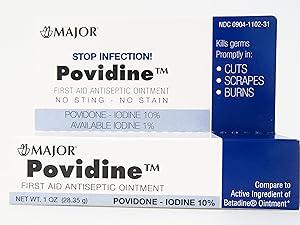How does the skin on your cat's back become red and irritated?
For some reason, your cat’s skin is not in its normal healthy shape in this case. We will discuss the possible causes later in this article. First we explain what exactly happens in the skin when red irritated skin has developed on your cat’s back.
As a result of damage to the skin cells and any blood vessels in the skin, substances are released from those damaged cells. These substances activate a whole system that will take care of the healing of the skin. At least that is what is being attempted. One substance ensures the production of another substance and that substance in turn causes the production of a third substance, etc. It is a very complicated system. But it causes the blood vessels that are still intact to open wide. In this way they allow a lot of blood to reach the damaged place, containing healing substances.
As a result of the blood vessels opening up completely, the damaged skin in that area looks very red and irritated. From those wide open blood vessels, a lot of fluid, containing the restorative substances such as proteins and immune cells, is also brought to the red and irritated area. This can cause the red and irritated skin in that area to become thickened. Because that moisture gets between the cells and pushes them apart. We also call a red and irritated skin a “dermatitis”, which is a difficult word for a skin inflammation.
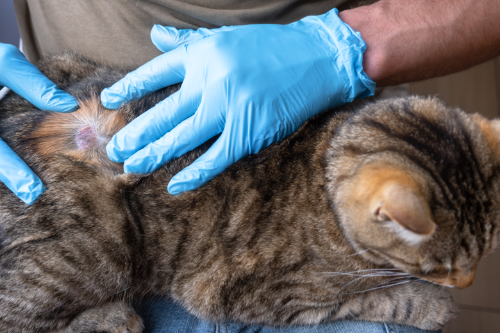
What could be the cause of red, irritated skin on your cat's back?
A wound from fighting, an accident or itching
Unfortunately, there are many options for the redness. In most cases a wound has occurred. This can be caused by your cat itself, because he experiences an itch and therefore scratches his own skin. But it can also be a wound as a result of a fight or accident. The exudate or blood will form a crust and the skin underneath and around it will look red due to the dilation of the blood vessels. In principle, your cat can heal such a wound on its own, so there is nothing to worry about.
A bacterial infection as the cause of red, irritated skin on your cat's back
Normal, harmless bacteria live on normal healthy skin. But as soon as the skin is damaged, those bacteria can settle in the wound. It is nice and warm there, nice and humid and therefore a nice place for those bacteria to multiply themselves. So there is a lot more bacteria in that red skin on your cat’s back. These bacteria will destroy the tissue even more than is was in the beginning. In addition, they cause more pain or itching, which can cause your cat to further damage the wound. “That’s great”, the bacteria think, because then they have more living space in that newly formed damaged tissue!
And so the spot gets bigger and bigger until your cat’s immune cells arrive on the spot to attack those bacteria. Only then a wound can heal. A wound infected with bacteria usually remains wet and sometimes even clearly purulent. So it usually doesn’t create a nice dry crust.
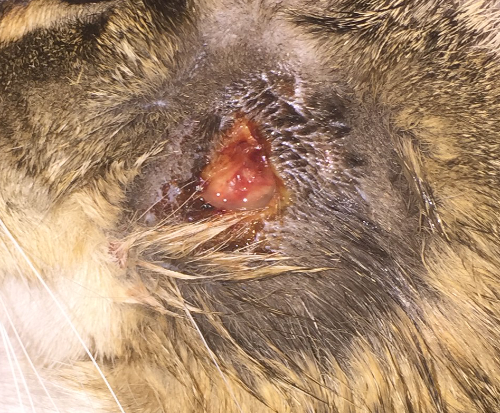
A yeast infection as the cause
But not only bacteria live on your cat’s skin. Yeasts also live there. And they can also cause the damaged skin to become increasingly red and irritated on your cat’s back. In fact, a yeast infection works much the same as a bacterial infection.
A fungal infection as the cause of red skin on your cat's back
A fungal infection, on the other hand, is a different story. Normally there are also a few fungi living on your cat’s skin, but they don’t cause problems. Things only go wrong if your cat has gotten an infection with a specific type of fungus. We call them Dermatophytes. There are three species in particular that cause skin problems in cats: Microsporum canis, Microsporum gypseum and a number of Trichophyton variants. The annoying thing is that these fungi also cause skin problems in you, the owner or in other animals in the house. So it’s contagious. And what makes it even more difficult is that your cat can also carry this fungus on its skin without having any problem himself, but it can infect the rest of the household again and again.
A fungus grows in skin and hair, damaging them. It can cause an itchy skin, but it doesn’t have to. Red and irritated spots appear in your cat’s skin. Baldness can occur. Your cat’s immune system is somewhat able to counteract that fungus, but as soon as it has suppressed part of it, the fungus will spread again. This often results in circular skin spots. In the center the skin seems to be healing, but on the edge it is still red and irritated skin. The spots keep getting bigger and bigger. This way you see a kind of ring forming, hence the name “ringworm”. However, it is not a worm, but a fungus.
In cats it is often more difficult to recognise as a ring. For comparison, the photo at the top of this page is a cat with a skin fungus where you can’t really see a ring.
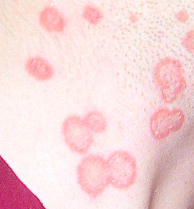
Parasites as the cause of red irritated skin on your cat's back
In general, lesions due to parasites are more scattered all over your cat’s back. For example, your cat may have fleas and, as a result, an itch and scratches himself. But there can also be a flea allergy. In that case, the cat will have many tiny crusts all over the backside of his back, near the tail. With a flea allergy, there is itching as a result of an allergic reaction to the saliva of the flea. Only 1 flea needs to be present and your cat is already very itchy. That is different from a flea problem in itself where the walking and jumping of the fleas cause the itch. You usually don’t have such a problem with one flea walking and jumping, but if there are 100 then it becomes an itchy story.
In addition to fleas, mites can also cause damage to the skin. There are several types of mites that we can find in cats. The Sarcoptes mite, the Cheyletiella mite, the Demodex mite and Notoedres mite. Very rarely, the ear mite also sometimes causes complaints on the back, but that is rarely the case. The mites live very deep in the skin or more superficially, but you cannot see them with the naked eye.
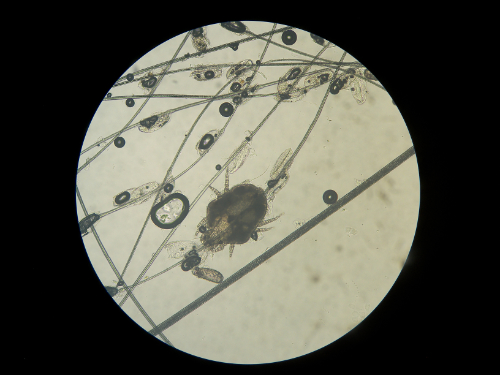
An allergy as the cause of a red and irritated skin on your cat's back
There are several possible allergies that can cause red and irritated skin on your cat’s back. For example, we have a food allergy, where there is an allergic reaction to a protein or grain in his food. Or we have an atopy in which there is an allergic reaction to substances that they inhale such as house dust mites, tree pollen, grass pollen, etc.
An allergic reaction usually only develops at the age of around 1-2 years. It very rarely occurs in animals that are much older. The tricky part is figuring out where your cat’s allergic reaction is coming from. We’ll discuss that later in this article.
What should you do if your cat has a red, irritated skin on its back?
If your cat has a red and irritated skin on its back for the first time, or at least very rarely, it is not really important at first what the cause is. You can already treat several things at the same time. But if it happens repeatedly you should start thinking about an allergy.
Destroy parasites.
For example, it is wise to pick up an anti-mite product at the counter of your vet. This product is also effective against fleas. For example, Stronghold, Bravecto, Advocate etc. all work against mites and fleas. But you can only buy these products at your vet.
That way you will treat mites, fleas and a flea allergy. And you probably already gave a flea treatment anyway, so this is not too big an investment. But is has a huge impact on healing.
Destroy bacteria and yeast
It is best if you go to your vet for an antibiotic and an anti-yeast agent. But actually that is not really necessary. Iodine also works well against bacteria and yeast. It is therefore wise to apply a thin layer of iodine ointment to your cat’s red, irritated skin twice a day. Usually you only need to do this for 5-7 days. Then the red and irritated spot should have healed. Make sure that your cat does not lick the iodine, otherwise he can get diarrhea. If he is going to lick it up, it is wise to put on a medical pet shirt.
Kill a fungal infection
If the red and irritated spot is still not gone after a week, you could try an anti-fungal cream to heal the spot. The condition is that the spot is small. Maximum 2cm in diameter and there are not many different places on your cat’s body. To treat a skin fungus you can use an athlete’s foot cream that contains miconazole nitrate. You apply this ointment 3 times a day on the spot and especially on the edge. Remember that the fungus grows outwards! Within a few days you should see the spot start to heal and within two weeks it should be completely gone. No new spots should be created. Otherwise, it is better to take your cat to your vet. The vet can prescribe medication that you can give your cat in his mouth so that his entire body is treated.
Treating an allergy
Has your cat had itchy complaints or wounds on its back for some time? And is he still in the early years of his life? Then you can do a food allergy test. This means that you will give him the following food for 8 weeks. In addition, he should absolutely not receive anything else. Because an allergy is an all or nothing reaction!! So a small piece of something he is allergic to causes long-term skin complaints. So give absolutely nothing else during the food allergy test. Otherwise the test is useless.
During the first 4 weeks there is probably no visible recovery yet. The substances your cat is allergic to are completely built into his body. It takes about 3 weeks for them all to disappear from his body. From the 4th week you can see that the red and irritated spots on his back are starting to recover. Has it not yielded anything after 8 weeks? Unfortunately it won’t happen ever. But if it did it is best to give this food the rest of his life.
When should you see your vet if your cat has red or irritated skin on its back?
If your cat is very bothered by it, it is wise to visit your vet. But also when the above treatments do not yield what you hoped for. Your vet can further investigate the red and irritated skin on your cat’s back and prescribe stronger medication. Your vet can also do a blood test to determine if, and for what your cat is allergic to. And of course you can still choose to have your vat take out a piece of skin under anesthesia and send it to a lab for examination. After all, there are always rare skin diseases that can also cause a red and irritated skin on your cat’s back.
Good luck!
We hope this article has given you an idea of what is causing the red irritated skin on your cat’s back. Hopefully he will recover soon. We wish you and your cat the best of luck.

